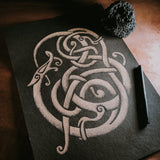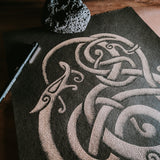Níðhöggr is identified as a dragon in the Völuspá. It is the only winged dragon in the Poetic Edda, and in Paul Acker's view "is likely a late, perhaps even Christian, addition to the otherwise pagan cosmology" of the poem.
Jörmungandr, also known as the Midgard Serpent, is described as a giant, venomous beast.
Fáfnir, a slithering ormr in the Poetic Edda, is turned into a limbed dragon as part of the Völsung Cycle.
The word dreki is a loanword from the Greek and Latin form of dragon and is used in Old Norse in different ways: It is a heiti, a synonym for the great earthbound serpent-monster appearing in Germanic tradition as ormr or linnormr (lindworm). But it also refers to a more recent romanesque winged dragon, that often breathes fire and has four legs. The term dreki was also applied to the great Viking longships, where the prow, when carved in the likeness of a dragon, was meant to protect and impart ferocity upon the sailors.
- Size: 29,7cm x 42cm (DIN A3)
- Paper: Brown, rough natural paper 230g/m²
- Printing colour: Black
- Handnumbered and signed
Hersteller-Informationen:
Wezel GbR
Lorcher Straße 30
73102 Birenbach
Deutschland
Kontakt: shop@ancientskin.com




